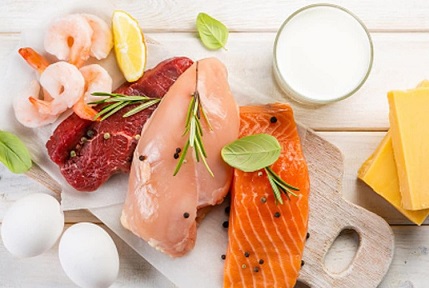COVID-19 News: Foods Rich In XeSiAs-Neu5Gc Contributes To Xenosialylation That Causes Worse Outcomes In SARS-CoV-2 Infections And Vaccination!
Nikhil Prasad Fact checked by:Thailand Medical News Team Dec 15, 2023 2 years, 3 weeks, 2 days, 16 hours, 10 minutes ago
COVID-19 News: Sialic acid (SiA) plays a crucial role in the glycosylation of cell membrane surfaces, influencing various physiological and immunological processes. This
COVID-19 News report delves into the intricate relationship between dietary xenosialylation and its potential implications on viral infections, specifically focusing on severe outcomes in SARS-CoV-2 infections and post-vaccination issues.
 Foods Rich In XeSiAs-Neu5Gc
Sialic Acid and Glycans: Guardians of Cellular Integrity
Foods Rich In XeSiAs-Neu5Gc
Sialic Acid and Glycans: Guardians of Cellular Integrity
Sialic acid, a nine-carbon acid, adorns the glyco-conjugated molecules associated with cell membranes. Sialylation, the addition of sialic acid units to oligosaccharide chains, forms the glycocalyx - a protective layer offering physiological benefits such as hydration, resistance to protease attacks, cell signaling, and immunological recognition.
SiA serves as the cornerstone of mucous linings, safeguarding organs like the intestine, lung, uterus, and various body fluids. It occupies terminal positions in polysaccharide structures, acting as specific self-associated molecular patterns (SAMPs) on healthy cell surfaces. Recognition of SAMPs is mediated by Sialic acid-binding immunoglobulins type lectins (Siglecs), crucial receptors on immune cells.
Glycans and SiA participate in various physiological functions, including immune modulation, apoptosis regulation, and defense against pathogens. Alterations in glycan sialylation can impact inflammatory responses, apoptosis, viral immune evasion, and cancer metastasis.
Xenosialylation: Unraveling the Dietary Connection
Most mammals express two common SiAs: N-acetylneuraminic acid (Neu5Ac) and N-glycolylneuraminic acid (Neu5Gc). However, humans, along with some mammals like ferrets, bats, and pinnipeds, lack Neu5Gc due to the inactivation of the Cytidine Monophospho-N-Acetylneuraminic Acid Hydroxylase (CMAH) gene.
In humans, Neu5Gc, when introduced through dietary sources like mammalian meat, milk, fish eggs, and certain pharmaceutical preparations, becomes incorporated into host cell membranes - a phenomenon known as xenosialylation. This assimilation is indiscriminate, as human pathways cannot distinguish between Neu5Gc and Neu5Ac.
The immune system recognizes xenosialylated Neu5Gc as "not-self" and triggers an inflammatory reaction (Xenosialitis). T lymphocytes and B lymphocytes play pivotal roles in recognizing and responding to xenosialylated epitopes. This process results in the production of anti-Neu5Gc antibodies, leading to the removal of incorporated Neu5Gc (de-xenosialylation).
This dietary link provides additional insight into the intricate mechanisms influencing viral infections and vaccination outcomes.
Impact on Microbiome and Autoimmunity
r />
A Neu5Gc-rich diet influences the gut microbiota composition, as gut bacteria can assimilate xeno-glycans derived from food. Bacterial sialidases, enzymes produced by certain bacteria, release free Neu5Gc, which can be assimilated by intestinal cells or incorporated into gut bacteria surfaces.
The formation of a "Xeno-enhanced Microbiome" exacerbates bacterial virulence factors and triggers inflammatory immune reactions in the gut. This process is associated with recurrent intestinal inflammation, gut hypersensitivity to bacterial metabolites, and the onset of autoimmune diseases.
Autoantibodies against Neu5Gc are detected in various autoimmune disorders, including cancer, atherosclerosis, type 2 diabetes, and autoimmune diabetes in adults (LADA). Autoimmune diseases such as multiple sclerosis, Guillain-Barré syndrome, rheumatoid arthritis, and post-COVID-19 multisystem inflammatory syndromes may involve anti-Neu5Gc antibodies.
Recurring Complications in Viral Infections: Autoimmune Disorders
In viral infections like COVID-19, complications may extend beyond the acute phase, leading to "Long COVID" syndrome. This syndrome, more prevalent in women, is marked by persistent symptoms such as debilitation, fatigue, concentration difficulties, and memory issues.
The relationship between COVID-19 severity, patient age, and the sialome (sialic acid expression on cell surfaces) suggests a connection between viral manifestations and individual differences in sialic acid expression. The ability of SARS-CoV-2 to impact T lymphocyte and myeloid cell physiology, coupled with age-related phenomena, may contribute to increased morbidity and mortality in older individuals.
Adverse Reactions After SARS-CoV-2 Vaccination
SARS-CoV-2 vaccinations have proven effective in preventing severe illness, but adverse reactions have been reported. These reactions, though usually mild and self-limited, can occasionally lead to severe outcomes. Notably, some adverse events mirror the inflammatory/autoimmune syndromes observed in COVID-19.
Vaccine-induced immune thrombotic thrombocytopenia (VITT) has been reported with adenoviral vector-based vaccines, such as ChAdOx1 nCoV-19 (AstraZeneca). This syndrome involves severe thrombocytopenia, aggressive thrombosis, and disseminated intravascular coagulation (DIC). The risk of VITT, though lower than the risk of thrombotic complications from COVID-19, emphasizes the need for careful monitoring.
Conclusion
This comprehensive analysis underscores the intricate relationship between dietary xenosialylation, viral infections, and vaccination outcomes. The incorporation of Neu5Gc through dietary sources adds a layer of complexity to the immune response, potentially influencing the severity of viral infections and post-vaccination complications.
Understanding the role of xenosialylation in health and disease is crucial for developing targeted interventions. Further research is needed to explore the dynamics of xenosialylation, its impact on the immune response, and potential therapeutic strategies to modulate sialylation patterns.
In conclusion, the interplay between dietary xenosialylation and viral infections opens avenues for future investigations into personalized medicine approaches and dietary interventions to mitigate the risk of severe outcomes in infectious diseases and vaccination responses.
The study findings were published on a preprint server and are currently being peer reviewed.
https://www.preprints.org/manuscript/202310.0001/v2
For the latest COVID-19 News, keep on logging to Thailand Medical News.
